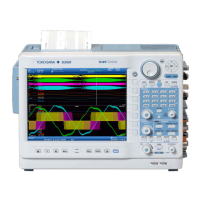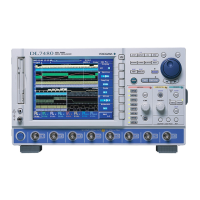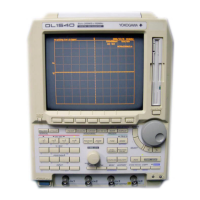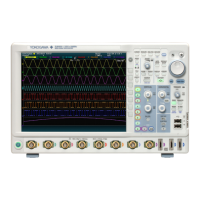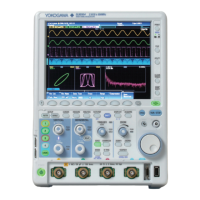2-12
IM DLM6054-01EN
section 6.3 for the procedure
Trigger Source
The trigger source is the signal that is used to check for the trigger condition.
Trigger Slope or Polarity
Slope refers to the signal movement from a low level to a high level (rising slope) or from a high
level to a low level (falling slope). When a slope is used as one of the trigger conditions, it is called
a trigger slope.
Trigger level
Trigger level refers to the level that the trigger source must pass through to trigger the DL6000/
DLM6000.
With simple triggers such as the edge trigger (see below for fu
rther details), the DL6000/DLM6000
triggers when the trigger source level passes through the specified trigger level.
Trigger level
The DL6000/DLM6000 triggers here when
the trigger edge is set to rising ( ).
Trigger source
* Edge: An edge is a point where the trigger source passes through the trigger level (or when
hysteresis is enabled, a point where the trigger source passes through the hysteresis
area around the trigger level).
section 6.2 for the procedure
When you start waveform acquisition, the DL6000/DLM6000 triggers on the set trigger condition and
displays the waveforms stored in the acquisition memory. When the trigger delay, explained in the next
section, is set to 0 s, the trigger position and the place where the trigger condition is met are the same.
By moving this trigger position on the screen, you can change the ratio between the portion of the
acquired waveform data displayed before the trigger point (pre-data), and the portion of the acquired
waveform data displayed after the trigger point (post-data).
section 6.2 for the procedure
The DL6000/DLM6000 normally displays waveforms before and after the trigger point. You can set a
trigger delay to display waveforms that the DL6000/DLM6000 has acquired a specified amount of time
after the trigger occurrence.
section 6.1 for the procedure
When Trigger Holdoff is set, the DL6000/DLM6000 will wait for a certain period of time after the
trigger event before it searches for the next trigger event. This is useful when you want to change the
acquisition interval. You may want to change the acquisition interval when you are dealing with pulse
string signals such as PCM signals or when you are using the history feature, which is discussed on
page 2-20.
2.3 Triggering

